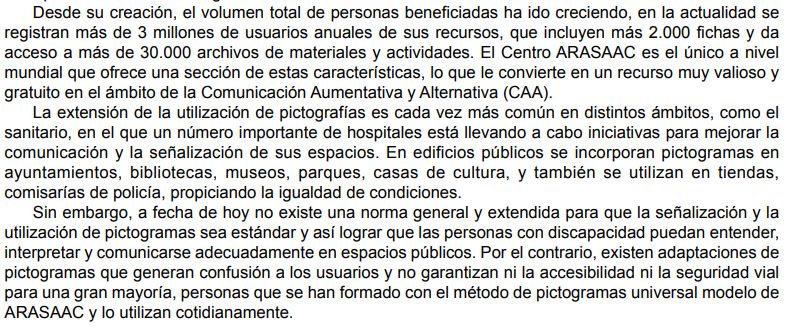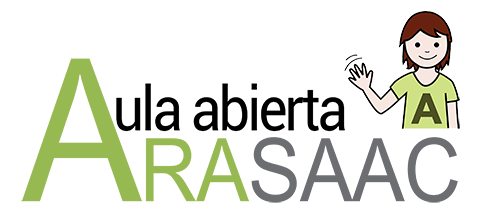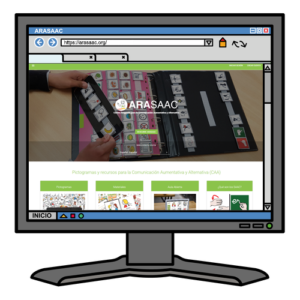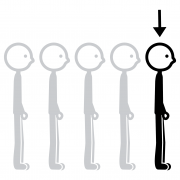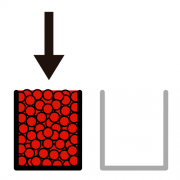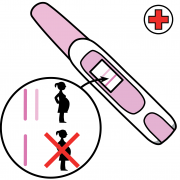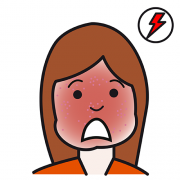 This work is licensed under a Creative Commons Attribution-NonComercial-ShareAlike 4.0 International license.
This work is licensed under a Creative Commons Attribution-NonComercial-ShareAlike 4.0 International license.
1. WHAT ARE PICTOGRAMS?
The word pictogram is a term that has its etymological origin in Greek and Latin, since it is made up of two words from these languages: “Picto”, which derives from the Latin adjective “pinctus” that can be translated as “painted” and “Grama”, which is a Greek word that means “written”. Therefore, pictograms are signs that, through a figure or a symbol, allow to develop the representation of something.

In the field of communication and cognitive accessibility, pictograms have become an essential tool for people who have difficulties in this area due to different factors (autism, intellectual disability, lack of knowledge of the language, the elderly, etc.).
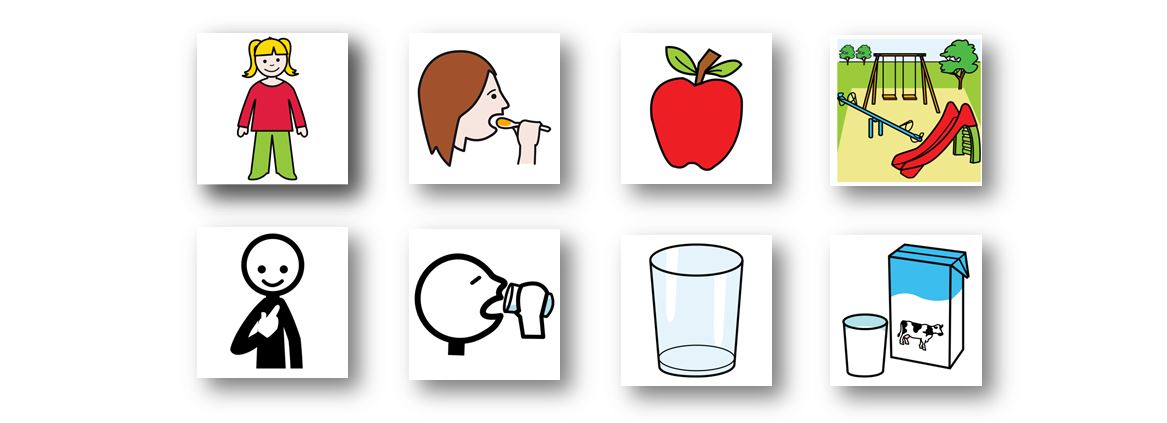
2. WHAT IS AUGMENTATIVE COMMUNICATION?
In 2018, the State Reference Center for Personal Autonomy and Technical Aids – CEAPAT carried out the project “Your opinion CuentAA, whose objective was to know the current situation of implementation and use of Augmentative and Alternative Communication (AAC) systems with support products,in order to design strategies and actions that improve communication with people who have limitations in this activity, and facilitate their social participation in equality.
After this prestigious study, CEAPAT defines AAC as the “means used by a person with difficulties in oral communication, to express themselves and interact effectively in any environment, counting on the necessary and appropriate supports to their abilities, whose use is shared with their interlocutors, and which allows them to exercise rights as well as their active participation in society, in equal opportunities.
- Augmentative Communication is considered when the medium used by the person complements and accompanies their oral communication.
- Alternative Communication is considered when the means used replace oral communication.
Both types of communication allow the person to unfold their full communicative potential.”

This definition arises as a result of the opinions on Augmentative and Alternative Communication collected in this project and that highlighted, mainly, the importance of having the appropriate supports for each person, the significant role of the interlocutor in the communicative process, and the recognition of communication as an inherent right of the human being.
Thus, this definition integrates any communicative means that allows a person to participate in a conversational context in an active way,respecting and recognizing said medium as valid and effective, if with its use the person communicates his will, interests, preferences, feelings or opinions.
In this way, this definition is aligned with the Convention on the Rights of Persons with Disabilities and its Committee which, in the General comment number 1 (2014). Article 12: Equal recognition as a person before the law, and with regard to the exercise of legal capacity, mentions:
“support in the exercise of legal capacity must respect the rights, will and preferences of persons with disabilities and must never consist in deciding for them (…) Support may also consist of the development and recognition of distinct and unconventional methods of communication, especially for those who use nonverbal forms of communication to express their will and preferences. (…)» (paragraph 17).
It further adds, in paragraph 29 (c), that:“a person’s mode of communication should not be an obstacle to obtaining support in decision-making, even when such communication is unconventional or when it is understood by very few persons”.
As can be seen, with the definition proposed from the project “Your opinion CuentAA, is intended to accommodate, in accordance with the provisions of the Committee, to any communicative means freely chosen by the person and that facilitates their social and effective interaction in any environment, as well as the exercise of their rights with the same opportunities.
In addition, the information obtained with the development of this project, also served as the basis for the preparation of the documents of the Series “Your opinion CuentAA”,whose reading is essential to know everything about the CAA with products and support technology.
Source: CEAPAT Factsheets on Augmentative and Alternative Communication
3. ARASAAC, PICTOGRAPHIC COMMUNICATION SYSTEM
Carmen Basil, one of the most prestigious PROFESSIONALS of the CAA at national and international level, defines augmentative and Alternative Communication Systems (AACS) as “forms of expression different from spoken language. which aim to increase (augmentative) and/or compensate (alternative) the communication and language difficulties of many people with difficulties in this area.
AACS include “various systems of symbols,both graphic (photographs, drawings, pictograms, words or letters) and gestures (mimicry, gestures or manual signs) and, in the case of the former, also requires the use of support products”.
These symbol systems are adapted to the needs of people with very different ages and motor, cognitive and linguistic abilities.
The most used pictographic systems in Spain are “the SPC system (Pictographic Communication System) and the ARASAACsystem, developed by the Aragonese Center for Augmentative and Alternative Communication” with a Creative Commons license (BY-NC-SA).
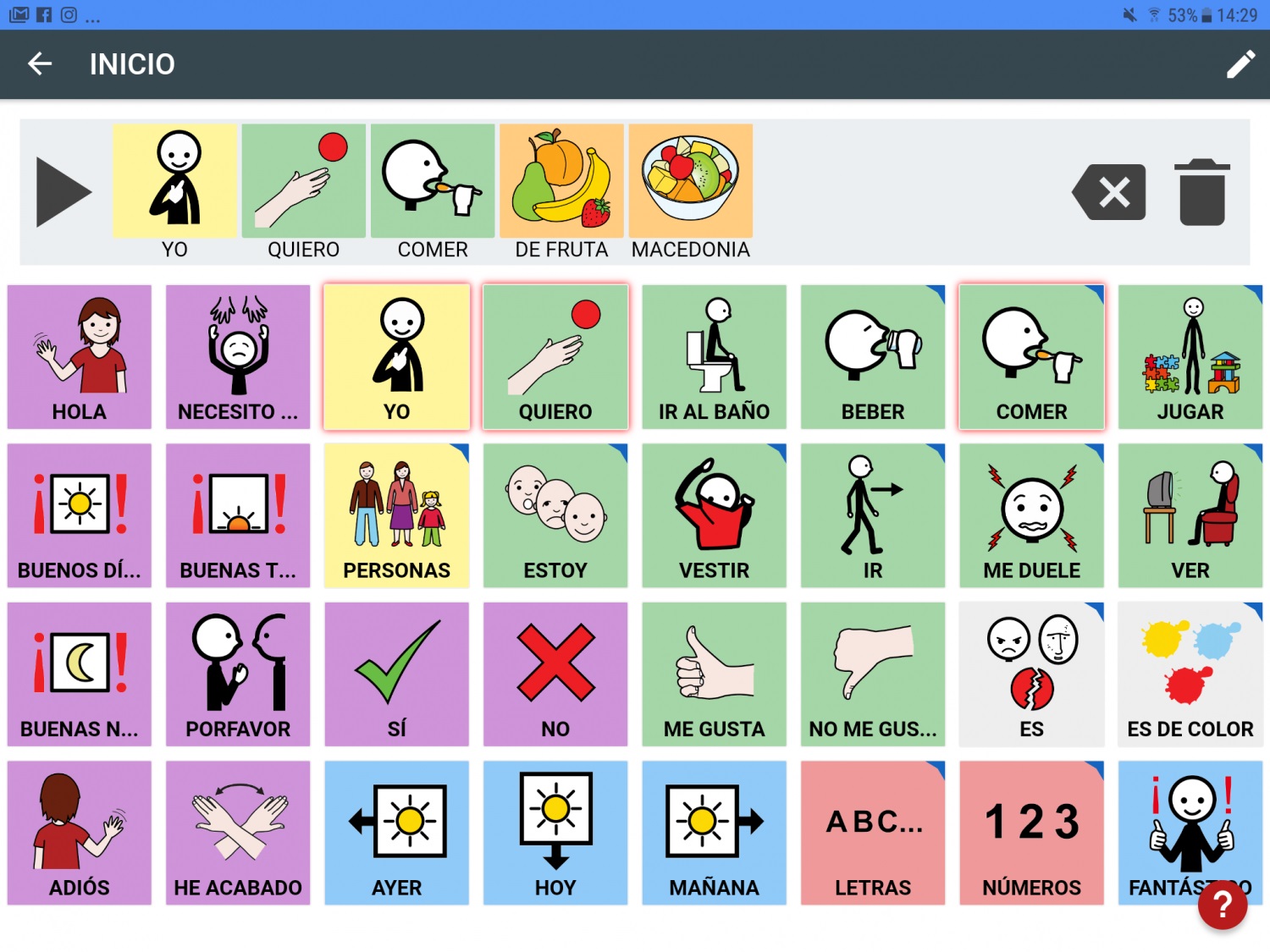 ARASAAC, pictographic communication system using pictograms
ARASAAC, pictographic communication system using pictograms
Pictographic communication systems should be considered “as a means or a necessary condition for the person with a speech disability to communicate, develop their abilities and participate in the world around them, but they are never sufficient. What is really important is the process of education, habilitation and advice that must accompany them.“.
4. EMPIRICAL ANALYSIS OF THE FORMAL CHARACTERISTICS OF ARASAAC
In 2015, Elisabetta Bertola López,under the direction of Francisco Cabello Luque,carried out her thesis on the“Empirical analysis of the formal characteristics of the pictographic symbols of ARASAAC”,which yields the first data of iconicity and validation of the pictograms of ARASAAC.
With all the usual precautions, these findings are very positive since thepictograms of ARASAAC show a high level of transparency,which also significantly exceeds those obtained for the SPC and Bliss sets in all the populations studied.
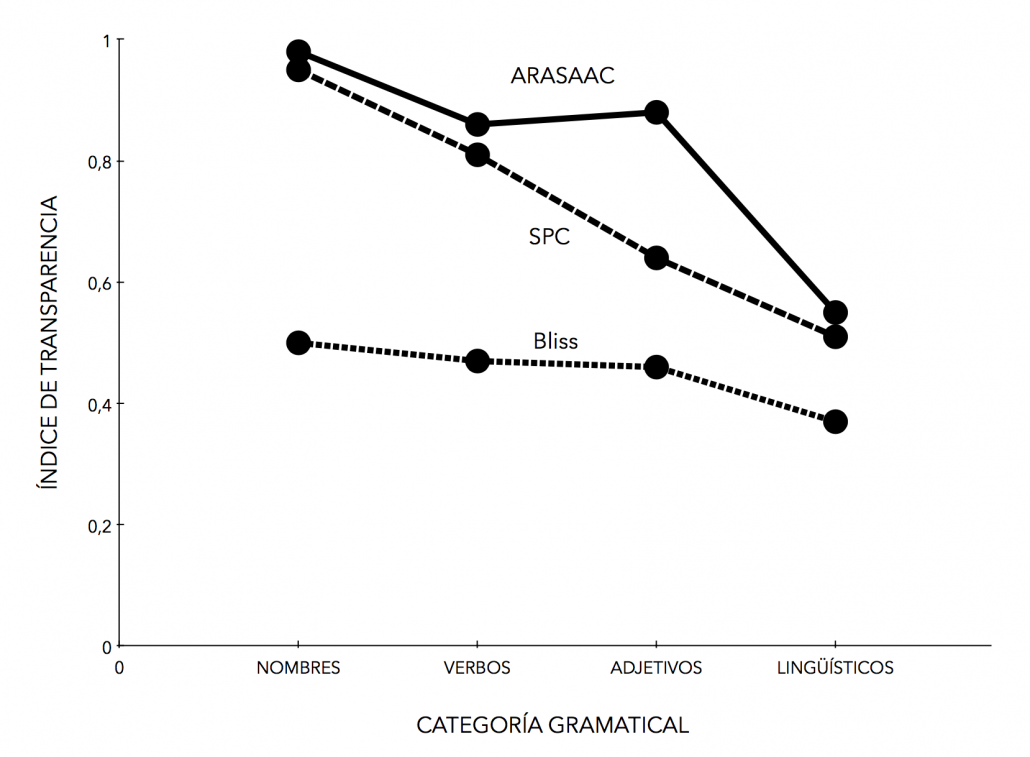
Of course, these results do not imply that ARASAAC is the best set of pictograms in absolute terms. On the contrary, the selection of one type or another of symbols will always have to adapt to the needs of each person, to their age, and to their motor, cognitive and linguistic skills. What this thesis provides is a sufficiently solid basis that demonstrates that pictograms possess adequate formal characteristics and that their meaning is easy to guess.
Therefore,the pictograms of ARASAAC are not only a set of symbols freely and freely available, but finally have evidence to support their use.
Source: Empirical analysis of the formal characteristics of ARASAAC pictographic symbols
5. CHARACTERISTICS OF ARASAAC AS A PICTOGRAPHIC COMMUNICATION SYSTEM
5.1- DESCRIPTIVE AND SCHEMATIC PICTOGRAMS.
ARASAAC offers a double aspect of pictograms: descriptive and schematic.
Descriptive pictograms are very useful in the first stages of implementation of a communication system by pictograms, since they are the link between reality (objects and photographs) and its graphic representation.
The schematic pictograms are designed to be used in more advanced stages, in which the user has a greater capacity for abstraction. They are also recommended to be used by adults with strokes, the elderly or people who do not know the language.
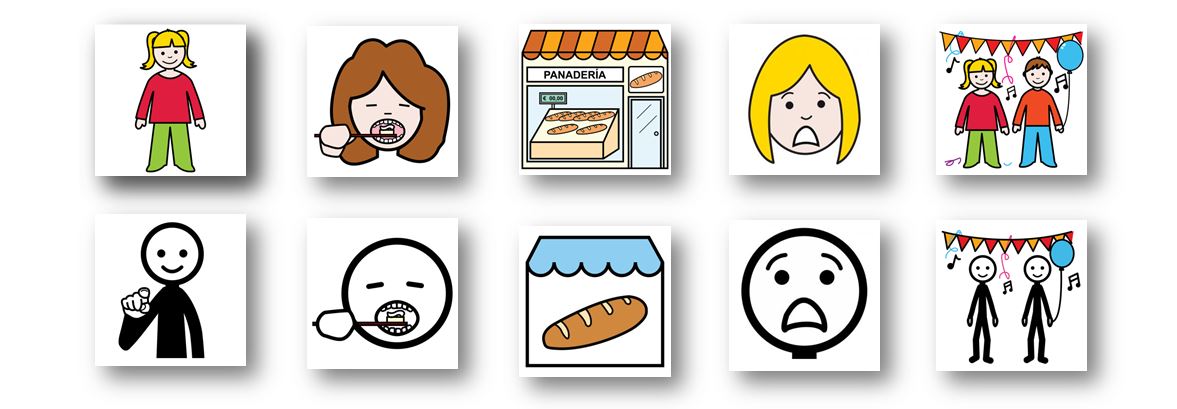
5.2- PICTOGRAMS OF ACTIONS
As in the previous paragraph, ARASAAC offers a unique variety: feminine/masculine and schematic pictograms.
Although current studies show that the level of abstraction required for its understanding is similar in all three cases, the database has all three models so that professionals and families can adapt them to the evolutionary characteristics, needs and cognitive capacity of users.

5.3- PICTOGRAMS FOR PLACES
In ARASAAC, graphic conventions are also used to differentiate pictograms representing buildings, rooms, rooms, workshops, factories, shops, etc. A box, the outline of a store or a factory help to differentiate the different places that are in our environment.

5.4 – PICTOGRAMS FOR INTANGIBLE CONCEPTS
Abstract concepts do not have a visual reference that helps us represent them graphically, although most of them derive from a real concept that is representable. In ARASAAC,the use of a “cloud” surrounding the tangible concept to represent the intangible concept has been adootado as a convention.
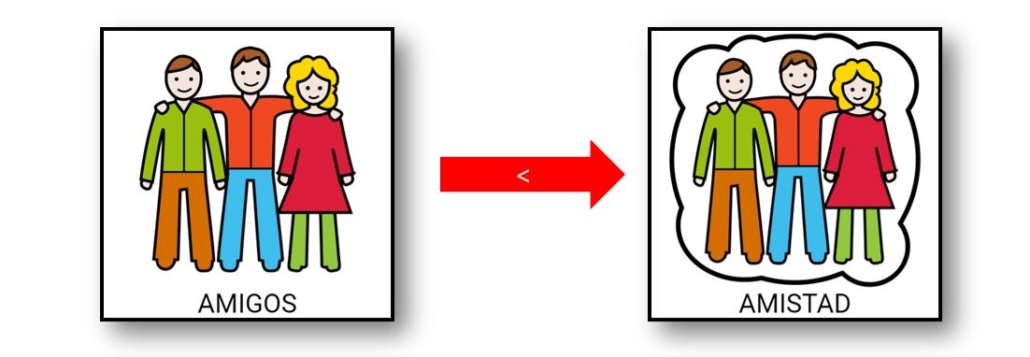
5.5 – PICTOGRAMS FOR PLURALITY
In ARASAAC,we use the + symbol to compose the plurals of words, since this sign is internationally recognized as a concept of plurality. When we use the plural of a pictogram, the + sign appears in the upper right part of it.
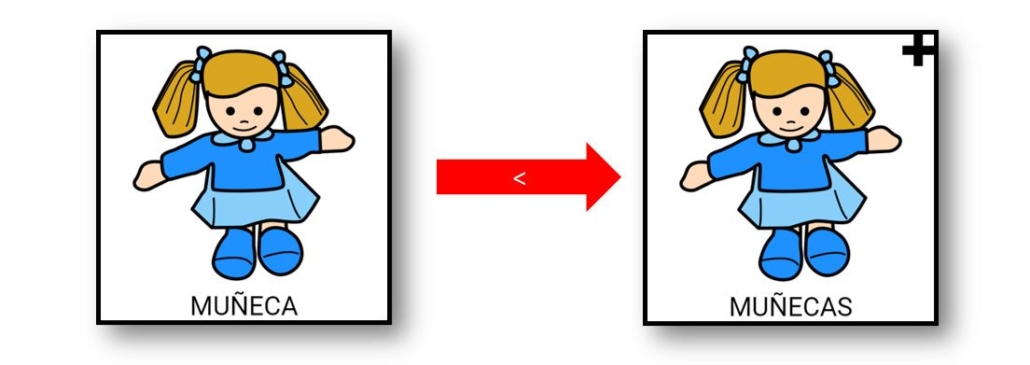
5.6 – INDETERMINATE CONCEPT IN PICTOGRAMS
On many occasions, it is necessary to use a wildcard in the design of the pictograms, which allows us to reference the given action or object to “something indeterminate”. In ARASAAC,that wildcard is represented through a red circle.
Let’s take an example. In the case of “have” actions we need to use that wild card to indicate that we can have different objects: a ball, an orange or a pen. You can not design a pictogram with each of the objects that we can have. Therefore, the convention of the red circle helps us to generalize this verb to different objects.

5.7- SOME CREATIVE LICENSES IN THE PICTOGRAMS
To represent some concepts, it is necessary to use some creative licenses in order to improve the understanding and significance of the concept represented.
On some occasions, an arrow can help to indicate what is the main element of the pictogram and what gives it meaning. The use of the color gray in the rest of the components of the pictogram highlights even more the attention on the message we want to convey, as in the case of the word “first”.
In the case of the pregnancy test, a magnifying glass has been used to highlight the essential element to understand the meaning of the pictogram. In this case, within the magnifying glass the two possible results of the pregnancy test are detailed. In other cases, the magnifying glass allows us to enlarge a part of the pictogram or indicate that something is or is put “inside”.
Finally, the exaggeration of certain actions, consequences or characteristics is also used to make their meaning more evident. This is the case of the pictogram that refers to allergy, in which the physical features have been exaggerated to differentiate it from the concept of “face”.
6. ARASAAC, A CLEAR REFLECTION OF TODAY’S SOCIETY
6.1- PICTOGRAMS FOR GENDER EQUALITY
Another of the basic premises of ARASAAC is respect for gender equality in all areas of daily life, so all actions, professions, activities, qualities, emotions, etc., are represented with pictograms of the male and female gender, which makes it a reference system in this sense and a model to follow.
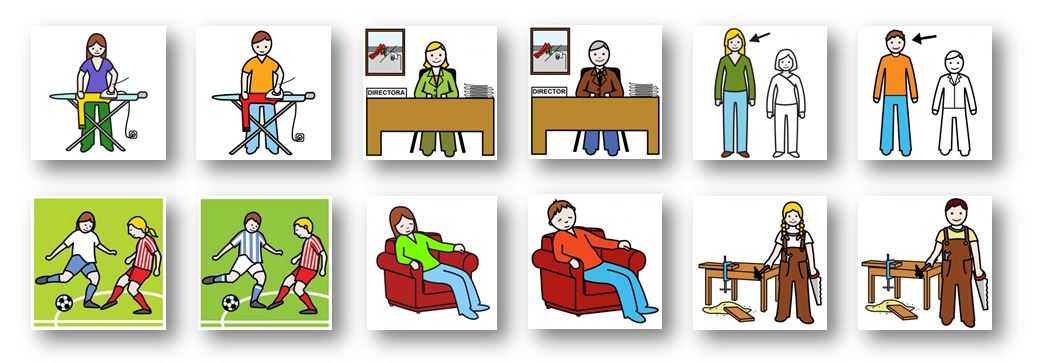
6.2- PICTOGRAMS FOR TODAY’S SOCIETY
Due to the demands of professionals from all areas, families and institutions, ARASAAC pictograms are a clear reflection of today’s society. In addition to the basic pictograms for communication in different environments (home, school, hospital, etc.), pictograms have been incorporated to combat gender violence, bullying or to face the pandemic caused by Covid-19, among other topics.
People with communication difficulties need these visual supports to understand, express and face complex situations that can seriously affect their daily lives.

6.3 – PICTOGRAMS THAT RESPECT DIFFERENCES
Respect for cultural, social or religious diversity is another of the key aspects of the ARASAACpictograms, since tolerance, solidarity and acceptance of all people are above personal ideologies.
The demands of pictograms from the different countries of the world, from the different culturers or religions help to enrich the vocabulary repertoire and for anyone with communication problems to have the necessary support to integrate fully into the society in which we all live.
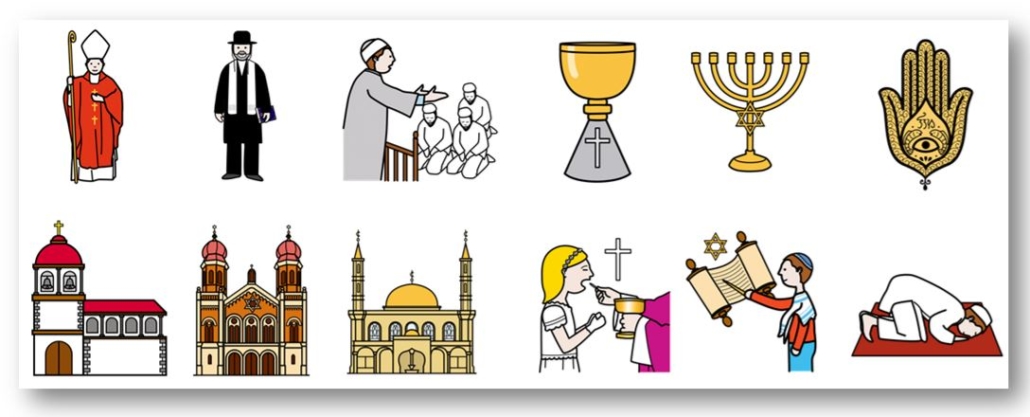
7. ARASAAC PICTOGRAMS AS VISUAL SUPPORT
Over the years, thanks to the altruistic collaboration of professionals from all fields, families and institutions, together with the characteristics of the pictograms and their Creative Commons license, the pictographic system of ARASAAC has also become a reference base within the visual supports.
On some occasions, there is some confusion about the term visual support and pictograms. Let’s clarify it, because one contains another.
“Intervention programs,both to structure the environment and adapt it to the person with autism in a way that facilitates their understanding and autonomy, and those that are aimed at improving communication and social interaction,are usually translated into a set of visual supports.”
These visual supports are tools that help transform verbal information into visual information with the aim of improving oral language comprehension. Among the most used visual supports we have gestures, objects, photographs, pictograms and the written word.
Through these visual supports we can elaborate materials such as communication boards, routines, agendas, anticipations,social stories, adaptations of the ordinary curriculum,etc.
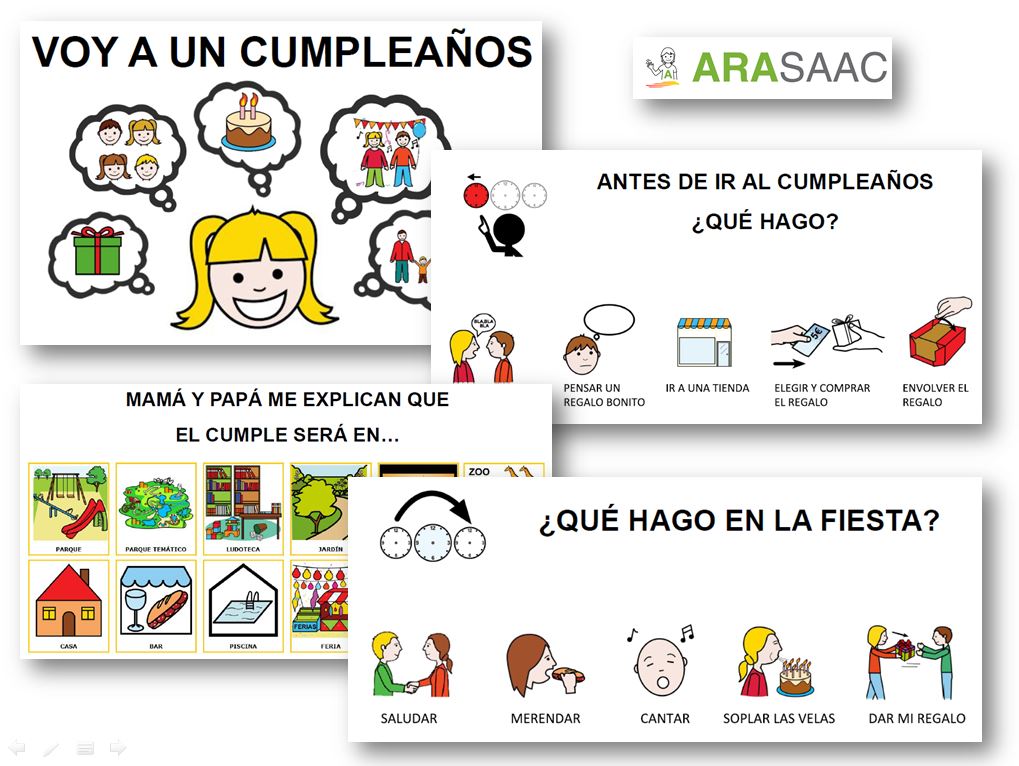 Social history to attend a birthday with pictograms of ARASAAC
Social history to attend a birthday with pictograms of ARASAAC
In parallel, many institutions and associations of families have used the pictograms of ARASAAC as visual supports in different areas (health, cultural, leisure, signage of public spaces, etc.) to enable the equal opportunities and full participation of all people in any activity of daily life.
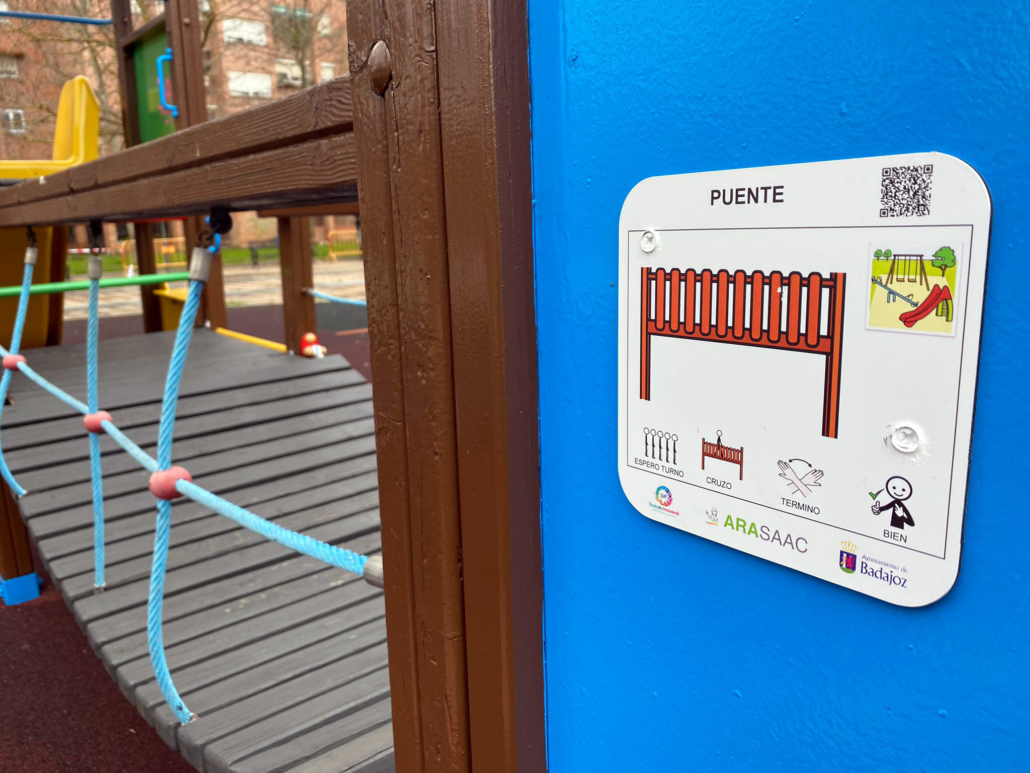 Signage of playgrounds with pictograms of ARASAAC – Asociación Badajoz Inclusivo
Signage of playgrounds with pictograms of ARASAAC – Asociación Badajoz Inclusivo
To join forces and unify the criteria for action in these areas, a Bill No of Law (PNL) has been unanimously approved by the Committee on Social Rights and Integral Disability Policies of the Congress of Deputies of Spain that urges the extension of the universal use of pictograms in public spaces and in which reference is made to the pictograms of ARASAAC as a pictographic reference system to be used.
